Even as a small child, Xan Irelia was fascinated by the grace and beauty of human movement. Under her grandmother’s tutelage, she learned the traditional silk dances of her province—though she was dubious of their supposedly mystical connection to the Spirit of Ionia, Irelia’s love for the dances was real. Seeking to master the art, she eventually left home to study with some of Ionia’s most respected performers at the Placidium of Navori.
Irelia’s people were peaceful and sought harmony with their neighbors, but rumors of foreign invaders sighted off the coast unsettled many at the Placidium. Irelia returned to her village to find it already occupied, with steel-helmed soldiers from distant Noxus shoving unarmed civilians through the streets with the butts of their spears. The Noxian Admiral Duqal had seized the Xan home to quarter his fleet officers.
Irelia’s brothers and her father Lito had evidently protested; her entire family now lay in unmarked graves, in the gardens.
Ravaged by grief, the young girl saw Duqal’s men hauling valuables from the house. Among the loot was a large metal crest, depicting the Xan family emblem. Irelia raced to it, wrenching it from Noxian hands. The admiral himself hurled her to the ground, and had his warriors shatter the crest with a heavy iron maul, before ordering them to dig a fresh grave for this upstart child.
As they surrounded her, Irelia averted her eyes, looking to the pieces of the Xan crest scattered on the ground. From deep within her soul, she felt a strange rhythm begin to beat. The shards of metal began to twitch, to twist, moving seemingly on their own, and Irelia felt the serene joy of the ancient dances once more...
With a sweep of her arm, she sent the pieces flying like ragged blades, cutting clean through two of the Noxians. As Duqal and his officers reeled in shock, Irelia snatched up the shards of her crest, and fled the village.
In the quiet forests beyond, Irelia mourned her family, and thought back to her grandmother’s teachings. She realized that the techniques she had learned were more than mere dances—they were a powerful expression of something far greater.
The Noxian occupation soon began to test the fragile peace of the First Lands. It was said that even the religious leader Karma had been forced to strike back at the invaders with deadly magic, though her followers had now withdrawn to the Lasting Altar and would not condone any further violence. Across Navori, dissenting voices began to band together. A resistance was forming, one that would not rest until Ionia was free once more. Irelia joined their ranks, performing her cherished dances for them in the woodland camps, to preserve some vestige of their vanishing culture.
She was barely fourteen years old when she found herself back at the Placidium. Her band of resistance fighters joined the militia who had sworn to guard the monasteries and wild, sacred gardens.
But Noxus knew only too well what this place represented. A particularly cunning general named Jericho Swain captured the Placidium and took its defenders hostage, hoping to lure the inevitable reinforcements into a trap.
It was in this moment that Irelia rose to meet her destiny. Freed from her bonds, she unleashed the full potential of her ancient blade dance, lashing out with graceful zeal. A dozen of Swain’s veterans fell, sowing chaos in their ranks as the other captives joined her, before she struck down the general himself—the sight of this rebellious girl hefting his severed arm over her head would be the turning point of the war.
This victory, the Great Stand at Navori, ensured that everyone in Ionia knew the name of Xan Irelia, and looked to her for leadership. Reluctantly, she led the growing resistance for almost three years of grueling battle before her triumph at Dalu Bay. There, she finally cornered the defeated Admiral Duqal, and exacted the vengeance she had sought for so long.
Though the war has long since ended, Ionia has been permanently changed by it. The First Lands are now divided, with rival factions fighting each other almost as bitterly as they did the Noxians. Many continue to look to Irelia for answers but, while others might welcome such power, Irelia remains uneasy with it.
At heart, she still yearns only to dance alone.
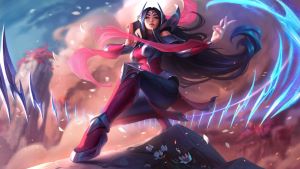
Ionia has always been a land of wild magic, its vibrant people and powerful spirits seeking to live in harmony… but sometimes this peaceful equilibrium does not come easily. Sometimes it needs to be kept in check.
The Kinkou are the self-appointed keepers of Ionia’s sacred balance. The order’s loyal acolytes walk the spirit and material realms, mediating conflicts between them and, when necessary, intervening by force. Born among their ranks was Akali, daughter of Mayym Jhomen Tethi, the renowned Fist of Shadow. Mayym and her partner Tahno raised their daughter within the Kinkou Order, under the watchful leadership of Great Master Kusho, the Eye of Twilight.
Whenever her parents were called away, other members of the order stepped in as Akali’s surrogate family. Kennen, the Heart of the Tempest, spent many hours with the young girl, teaching her shuriken techniques, and emphasizing speed and agility over strength. Akali was a precocious child, and soaked up the knowledge like a sponge. It became clear to all that she would follow her parents’ path—along with the Great Master’s son and appointed successor Shen, she would lead a new generation dedicated to preserving Ionia’s balance.
But balance can be fleeting. The order found itself divided.
A wayward acolyte named Zed returned, and clashed violently with Kusho, wresting power in a bloody coup. Akali fled into the eastern mountains along with Mayym, Shen, Kennen, and a handful of other acolytes. Sadly, Tahno was not among them.
Zed’s transformation of the Kinkou into the merciless Order of Shadow was almost complete. But, as the new Eye of Twilight, Shen intended to rebuild what had been lost. They would return to the Kinkou’s three fundamental philosophies: the pure impartiality of Watching the Stars, the passage of judgment in Coursing the Sun, and the elimination of imbalance by Pruning the Tree. Even though they were now few, they would train neophytes to restore and grow their numbers once more.
When Akali came of age at fourteen, she formally entered her Kinkou training, determined to succeed her mother as the new Fist of Shadow.
She was a prodigious fighter, and mastered the kama and kunai—a handheld sickle and throwing dagger. Though she did not possess the magical abilities of many of her fellow acolytes, she proved to all she was worthy of the title, in time allowing her mother to step down and help mentor the younger neophytes.
But Akali’s soul was restless, and her eyes were open. Though the Kinkou and the Order of Shadow had come to an uneasy accord in the wake of the Noxian invasion of Ionia, she saw that her homeland continued to suffer. She questioned whether they were truly fulfilling their purpose. Pruning the Tree was meant to eliminate those who threatened the sacred balance... yet Shen would always urge restraint.
He was holding her back. All the mantras and meditations could quiet her spirit, but such platitudes would not defeat their adversaries. Her youthful precociousness turned to outright disobedience. She argued with Shen, she defied him, and she took down Ionia’s enemies her way.
In front of the whole order, she declared the impotence of the Kinkou, all its talk of spiritual balance and patience accomplishing little. Ionians were dying in the material realm, and that was the realm Akali would defend. She was trained as an assassin. She was going to be an assassin. She did not need the order anymore.
Shen let her go without a fight, knowing this was a path that Akali must walk alone. Perhaps that path would bring her back one day, but that would be for her to decide.
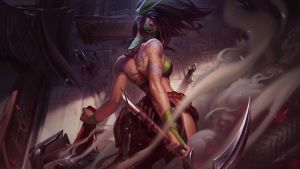
Noxian by birth, Shieda Kayn and others like him were conscripted as child soldiers, a cruel practice employed by only the most devious commanders in Boram Darkwill’s empire. Following the disastrous battle at the Placidium of Navori, the invasion was deliberately reformulated into a protracted war of attrition. Ionian compassion was a weakness to be exploited—their warriors would hesitate before striking down a supposed innocent. Thus, barely able to lift the blade he had been given, Kayn’s first day in battle was also expected to be his last.
Striking against the province of Bahrl, Noxian forces landed at the mouth of the Epool River. Kayn and the others were a reluctant vanguard, facing disorganized bands of locals defending their home from these returning invaders. While his young comrades were cut down or fled the battlefield, Kayn showed no fear. He dropped his heavy sword and snatched up a fallen sickle, turning to face the shocked Ionians just as the Noxian regulars swept in from the flank.
The carnage was staggering. Farmers, hunters—even a handful of vastaya—all were butchered without ceremony.
Two days later, after word had spread throughout the southern provinces, the Order of Shadow came upon the grisly scene. Their leader, Zed, knew this area had no tactical significance. This massacre was intended as a message. Noxus would show no mercy.
A flickering glint of steel caught his eye. A child of no more than ten lay in the mud, leveling his broken sickle at the master assassin, bloody knuckles straining white. The boy’s eyes harbored a pain that belied his age, yet still burned with all the fury of a hardened warrior. This tenacity was not something that could be taught. Zed saw in this child, this abandoned Noxian survivor, a weapon that could be turned against those who had sent him here to die. The assassin held out his hand and welcomed Kayn into the Order of Shadow.
Acolytes traditionally spent years training with a single weapon of their choosing, but Kayn mastered them all—to him, they were mere tools, and he was the weapon. Armor he viewed as a cumbersome burden, instead cloaking himself in shadows and slaying his enemies with quickness and stealth. These swift executions instilled fear in the hearts of those fortunate enough to be spared.
And as Kayn’s legend grew, so did his arrogance. He truly believed that one day his power would eclipse even that of Zed himself.
This hubris led Kayn to embrace his final test: to seek out a darkin weapon recently unearthed in Noxus, and prevent it from ever being used against the weary defenders of Ionia. He accepted without hesitation, never questioning why he had been chosen for this task. Indeed, where any other acolyte would have destroyed the living scythe known as Rhaast, Kayn took it for himself.
The corruption took hold the moment his fingers closed around the weapon, locking them both in a fateful struggle. Rhaast has long awaited the perfect host in order to rejoin its darkin brethren and lay waste to the world, but Kayn will not be easily dominated. He returns to Ionia in triumph, convinced that Zed will name him the new leader of the Order of Shadow.
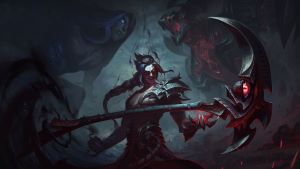
Beneath Ionia’s veil of harmony lie the tales of those left behind. For Zed, his story began as a boy on the cold steps of the home of the Kinkou Order.
Taken in by Great Master Kusho himself, Zed found his place within the temple’s ancient walls. He dedicated himself to understanding the Kinkou’s spiritual tenets, quickly outpacing his peers both in combat and study. Even so, he felt overshadowed by another—his master’s son, Shen. Though Zed’s passion shone through in every technique he perfected, he lacked Shen’s emotional balance. In spite of this, the two pupils became like brothers.
In time, they journeyed together with their master to track down the infamous Golden Demon. When they finally succeeded in capturing this feared “monster,” it was revealed to be a mere man named Khada Jhin. The young Zed marched forward with his blades held high, but Kusho stopped him, ordering that Jhin be imprisoned instead.
Returning to their temple, Zed’s heart bloomed with resentment, and he began to struggle in his studies. He was haunted by the memories of Jhin’s grisly murders, and rising tensions between Ionia and the imperialistic forces of Noxus only worsened his disillusionment. While Shen was growing to adopt his father’s dispassion, Zed refused to let lofty notions of balance stand in the way of punishing evil.
He ventured deep into the temple’s hidden catacombs, and there he discovered an ornate, black box. Even though he knew it was forbidden to any but the masters of the order, he peered inside.
Shadows enveloped Zed’s mind, feeding his bitterness with contempt for the weak, and hinting at an ancient, dark magic.
Returning to the light of the temple, he came face to face with Great Master Kusho. Zed demanded the Kinkou strike at the Noxian invaders with every means at their disposal. When Kusho refused, Zed turned his back on the order that had raised him.
Unbound by Kinkou doctrine, he raised a following of warriors to resist Noxus. Any soul who threatened his homeland, or stood idle in its defense, was marked for death without mercy—including native vastaya who wavered in their allegiance. Zed urged his followers to embrace the fervor of war, but soon enough he realized his own abilities would never match his ambitions without the black box.
Amassing his new acolytes, he returned to the Kinkou temple, where he was met by Kusho. The elderly man laid his weapons at Zed’s feet, imploring his former pupil to renounce the shadows in favor of a more balanced path.
Moments later, Zed emerged back onto the temple steps. In one hand, he grasped the box—and in the other, his freshly bloodied blade.
The Kinkou, frozen with shock, fell in droves as Zed’s warriors cut them down. He then claimed the temple for himself, establishing his Order of Shadow, and began training his acolytes in the ways of darkness. They etched their flesh with shadowy tattoos, learning to fight alongside shrouded reflections of themselves.
Zed took advantage of the ongoing war with Noxus, and the suffering it brought to the Ionian people. In the wake of a massacre near the Epool River, he came upon Kayn, a Noxian child soldier wielding nothing but a farmer’s sickle. Zed could see the boy was a weapon waiting to be sharpened, and took him as his personal student. In this young acolyte, he saw a purity of purpose to match his own. In Kayn, Zed could see the future of the Order of Shadow.
Though he did not reconcile with Shen and the remaining Kinkou, now scattered throughout the provinces, they reached an uneasy accord in the aftermath of the war. Zed knew what he had done could not be undone.
In recent years, it has become clear that the balance of the First Lands has been disrupted, perhaps forever. For Zed, spiritual harmony holds little consequence—he will do what needs to be done to see Ionia triumph.
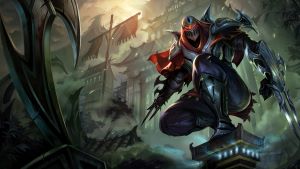
One can travel to nearly any village across Ionia and hear the tale of the Capture of the Golden Demon. Depicted in a variety of plays and epic poems, the cruel spirit’s banishment is still celebrated to this day.
But at the heart of every myth there lies a kernel of truth, and the truth of the Golden Demon is one far different than the fiction.
For years, Ionia’s southern mountains were plagued by the infamous creature. Throughout the province of Zhyun, and even as far as Shon-Xan and Galrin, a monster slaughtered scores of travelers and sometimes whole farmsteads, leaving behind twisted displays of corpses. Armed militias searched the forests, towns hired demon hunters, Wuju masters patrolled the roads—but nothing slowed the beast’s grisly work.
In desperation, the Council of Zhyun sent an envoy to beg Great Master Kusho of the Kinkou Order for help. Charged with maintaining the balance between the spirit and material realms, Kusho was adept in the banishment of demons. Leaving in secret lest the cunning creature be alerted to their intent, Kusho, his teenage son, Shen, and young apprentice, Zed, traveled to the province. They tended to countless families shattered by the killings, dissected the horrific crime scenes, and looked for connections between the murders. Soon, Kusho realized they were far from the first to hunt this killer, and his conviction grew that this was the work of something beyond the demonic.
For the next four years, the Golden Demon remained beyond their reach, and the long investigation left the three men changed. The famous red mane of Kusho turned white; Shen, known for his wit and humor, became somber; and Zed, the brightest star of Kusho’s temple, began to struggle with his studies. It was almost as though the demon knew they were seeking it, and delighted in the torment sown by their failure.
Upon finally finding a pattern to the killings, the Great Master is quoted as saying: “Good and evil are not truths. They are born from men, and each sees the shades differently.” Kusho sought to hand off the investigation, believing now that they sought not a demon, but a wicked human or vastaya, taking them beyond the Kinkou’s mandate. Shen and Zed, unwilling to turn back after all they had sacrificed to bring the killer within reach, convinced him to continue the hunt.
On the eve of the Spirit Blossom Festival in Jyom Pass, Kusho disguised himself as a renowned calligrapher to blend in with the other guest artists. Then he waited. Shen and Zed laid a carefully prepared trap, and at long last, they found themselves face to face with their hated quarry. Kusho was proven right—the famed “Golden Demon” was a mere stagehand in Zhyun’s traveling theaters and opera houses, working under the name Khada Jhin.
After they caught Jhin, young Zed made to kill the cowering man, but Kusho held him back. He reminded his students that they had already broken their remit, and that killing Jhin would only worsen matters. Kusho worried that knowledge of Jhin’s humanity would undermine the harmony and trust that defined Ionian culture, or could even encourage others to commit similar crimes. Despite Jhin’s actions, the legendary master decided the killer should be taken alive and locked away within the monastery prison at Tuula.
Shen disagreed, but submitted to the emotionless logic of his father’s judgment. Zed, disturbed and haunted by the horrors he had witnessed, was unable to understand or accept this mercy, and it is said a resentment began to bloom in his heart.
Imprisoned in Tuula, Jhin kept his secrets, revealing little of himself as many years went by. The monks guarding him noted he was a bright student who excelled in many subjects, including smithing, poetry, and dance. Regardless, they could find nothing to cure him of his morbid fascinations. Meanwhile, outside the monastery’s walls, Ionia fell into turmoil as the Noxian empire invaded, and war awoke the tranquil nation’s appetite for bloodshed.
Jhin was freed from Tuula sometime after the war with Noxus, possibly put to use by one of the many radical elements vying for power of the First Lands near the conflict’s end. He now has access to the Kashuri armories’ new weapons, though how he came to possess such implements of destruction, and what connection he has to Kashuri, is still a mystery.
Whoever his shadowy patrons might be, they have endowed Jhin with nearly unlimited funds, and seem unconcerned by the growing scale of his “performances”. Recently, he attacked members of Zed’s Yanlei order, and mass murders and assassinations bearing his signature “flair” have occurred not only across Ionia’s many regions, but also in distant Piltover and Zaun.
It seems that all of Runeterra might be but a canvas for the atrocity that is Khada Jhin’s art, and only he knows where the next brushstroke will fall.
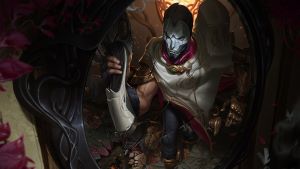
One can travel to nearly any village across Ionia and hear the tale of the Capture of the Golden Demon. Depicted in a variety of plays and epic poems, the cruel spirit’s banishment is still celebrated to this day.
But at the heart of every myth there lies a kernel of truth, and the truth of the Golden Demon is one far different than the fiction.
For years, Ionia’s southern mountains were plagued by the infamous creature. Throughout the province of Zhyun, and even as far as Shon-Xan and Galrin, a monster slaughtered scores of travelers and sometimes whole farmsteads, leaving behind twisted displays of corpses. Armed militias searched the forests, towns hired demon hunters, Wuju masters patrolled the roads—but nothing slowed the beast’s grisly work.
In desperation, the Council of Zhyun sent an envoy to beg Great Master Kusho of the Kinkou Order for help. Charged with maintaining the balance between the spirit and material realms, Kusho was adept in the banishment of demons. Leaving in secret lest the cunning creature be alerted to their intent, Kusho, his teenage son, Shen, and young apprentice, Zed, traveled to the province. They tended to countless families shattered by the killings, dissected the horrific crime scenes, and looked for connections between the murders. Soon, Kusho realized they were far from the first to hunt this killer, and his conviction grew that this was the work of something beyond the demonic.
For the next four years, the Golden Demon remained beyond their reach, and the long investigation left the three men changed. The famous red mane of Kusho turned white; Shen, known for his wit and humor, became somber; and Zed, the brightest star of Kusho’s temple, began to struggle with his studies. It was almost as though the demon knew they were seeking it, and delighted in the torment sown by their failure.
Upon finally finding a pattern to the killings, the Great Master is quoted as saying: “Good and evil are not truths. They are born from men, and each sees the shades differently.” Kusho sought to hand off the investigation, believing now that they sought not a demon, but a wicked human or vastaya, taking them beyond the Kinkou’s mandate. Shen and Zed, unwilling to turn back after all they had sacrificed to bring the killer within reach, convinced him to continue the hunt.
On the eve of the Spirit Blossom Festival in Jyom Pass, Kusho disguised himself as a renowned calligrapher to blend in with the other guest artists. Then he waited. Shen and Zed laid a carefully prepared trap, and at long last, they found themselves face to face with their hated quarry. Kusho was proven right—the famed “Golden Demon” was a mere stagehand in Zhyun’s traveling theaters and opera houses, working under the name Khada Jhin.
After they caught Jhin, young Zed made to kill the cowering man, but Kusho held him back. He reminded his students that they had already broken their remit, and that killing Jhin would only worsen matters. Kusho worried that knowledge of Jhin’s humanity would undermine the harmony and trust that defined Ionian culture, or could even encourage others to commit similar crimes. Despite Jhin’s actions, the legendary master decided the killer should be taken alive and locked away within the monastery prison at Tuula.
Shen disagreed, but submitted to the emotionless logic of his father’s judgment. Zed, disturbed and haunted by the horrors he had witnessed, was unable to understand or accept this mercy, and it is said a resentment began to bloom in his heart.
Imprisoned in Tuula, Jhin kept his secrets, revealing little of himself as many years went by. The monks guarding him noted he was a bright student who excelled in many subjects, including smithing, poetry, and dance. Regardless, they could find nothing to cure him of his morbid fascinations. Meanwhile, outside the monastery’s walls, Ionia fell into turmoil as the Noxian empire invaded, and war awoke the tranquil nation’s appetite for bloodshed.
Jhin was freed from Tuula sometime after the war with Noxus, possibly put to use by one of the many radical elements vying for power of the First Lands near the conflict’s end. He now has access to the Kashuri armories’ new weapons, though how he came to possess such implements of destruction, and what connection he has to Kashuri, is still a mystery.
Whoever his shadowy patrons might be, they have endowed Jhin with nearly unlimited funds, and seem unconcerned by the growing scale of his “performances”. Recently, he attacked members of Zed’s Yanlei order, and mass murders and assassinations bearing his signature “flair” have occurred not only across Ionia’s many regions, but also in distant Piltover and Zaun.
It seems that all of Runeterra might be but a canvas for the atrocity that is Khada Jhin’s art, and only he knows where the next brushstroke will fall.
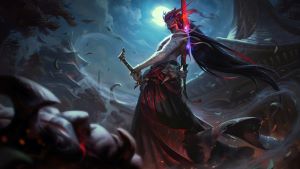
As a child, Yasuo often believed what the others in his village said of him: on the best days, his very existence was an error in judgement; on the worst, he was a mistake that could never be undone.
Like most pain, there was some truth to it. His mother was a widow already raising a young son, when the man who would be Yasuo’s father blew into her life like an autumn wind. And, just like that lonely season, he was gone again before the blanket of Ionian winter settled over the small family.
Even though Yasuo’s older half-brother, Yone, was everything Yasuo was not—respectful, cautious, conscientious—the two were inseparable. When other children teased Yasuo, Yone was there to defend him. But what Yasuo lacked in patience, he made up for in determination. When Yone began his apprenticeship at the village’s renowned sword school, a young Yasuo followed, waiting outside in monsoon rain, until the teachers relented and opened the gates.
Much to the annoyance of his new peers, Yasuo showed natural talent, and became the only student to catch the attention of Elder Souma, last master of the legendary wind technique. The old man saw Yasuo’s potential, but the impulsive pupil refused his tutelage, remaining unbridled like a whirlwind. Yone pleaded with his brother to set aside his arrogance, gifting him a maple seed, the school’s highest lesson in humility. The next morning, Yasuo accepted the position as Souma’s apprentice, and personal bodyguard.
When word of the Noxian invasion reached the school, some were inspired by the great stand that had been taken at the Placidium of Navori, and soon the village was bled of the able bodied. Yasuo longed to add his sword to the cause, but even as his classmates and brother left to fight, he was ordered to remain and protect the elders.
The invasion became a war. Finally, one rain-slicked night, the drums of a Noxian march could be heard in the next valley over. Yasuo abandoned his post, foolishly believing he could turn the tide.
But he found no battle—only a raw grave for hundreds of Noxian and Ionian corpses. Something terrible and unnatural had happened here, something that no single blade could have stopped. The land itself seemed tainted by it.
Sobered, Yasuo returned to the school the next day, only to be surrounded by the remaining students, their swords drawn. Elder Souma was dead, and Yasuo found himself accused not only of dereliction, but of murder. He realized the true killer would go unpunished if he did not act quickly, so he fought his way free, though he knew this would all but confirm his apparent guilt.
Now a fugitive in war-torn Ionia, Yasuo sought any clue that might lead him to the murderer. All the while, he was hunted by his former allies, continually forced to fight or die. This was a price he was willing to pay, until he was tracked down by the one he dreaded most—his own brother, Yone.
Bound by honor, they circled each other. When their swords finally met, Yasuo’s wind magic overcame Yone’s dual blades, and with a single flash of steel, the outcast cut his brother down.
He begged forgiveness, but Yone’s dying words were of the wind techniques responsible for Elder Souma’s death, and that his brother was the only one who could have known them. Then he fell silent, passing on before he could grant any absolution.
Without master or brother, Yasuo roamed the mountains distraught, drinking away the pain of war and loss, a sword without a sheath. There in the snow, he met Taliyah, a young Shuriman stone mage who had fled the Noxian military. In her, Yasuo saw an unlikely student, and in himself, an even more unlikely teacher. He trained her in the ways of elemental magic, wind shaping stone, embracing at last the teachings of Elder Souma.
Their world changed with rumors of a risen Shuriman god-emperor. Yasuo and Taliyah parted ways, though he gifted her the treasured maple seed, its lesson now learned. As she returned to her native desert sands, Yasuo set out for his own village, determined to put right his mistakes and find his old master’s true killer.
Within the stone walls of the council hall, Elder Souma’s death was revealed to have been an accident, one brought about by the Noxian exile known as Riven—and one for which she felt deep remorse. Even so, Yasuo still could not absolve himself of the choice he had made to abandon his master or, worse yet, how that choice had ultimately led to Yone’s death.
Yasuo eventually journeyed to the spirit blossom festival in Weh’le, though he held little hope that its healing rituals would ease his heart. It was there he encountered a demonic creature that sought to devour him, an azakana that fed on his pain and regret.
Yet a masked intruder intervened, striking down the creature with righteous fury, and Yasuo realized he knew this man—it was Yone.
Fully expecting his brother to take vengeance, Yasuo was surprised when Yone let him go with little more than a bitter blessing.
With nothing left for him in the First Lands, Yasuo has embarked on a new adventure, though he knows not where it will lead, his sense of guilt the only thing weighing down the free wind.
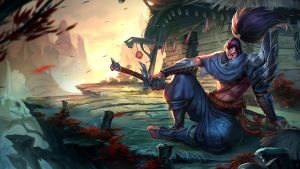
Vytvořil: Dominik Fritz©, E-mail: fritz@gvp.cz